“Before you go, here, this is for you.” said my instructor as he handed me a small plastic folder.
The big bold words “PPL Course Starter Pack” decorating the cover-page made my heart beat just a bit faster. Hardly imaginable, given that my heart rate must’ve already been at it’s peak from the excitement the discovery flight had given me.
Of course, just as I imagine you have, dear reader, I ran home and studied this collection of documents with the utmost urgency as if they contained the secret key to solving all of history’s mysteries, which would fade into non-existence if the reading was delayed by even the shortest amount of time.
Membership form, club regulations, flying medicals and ah, yes.
The PPL (A) Ground Exams.
Dramatic intro aside, I expected the theory component of the PPL course. But what does that mean exactly? And where do I get this knowledge from? Can I choose where I sit these exams? And what is the expected timeline?
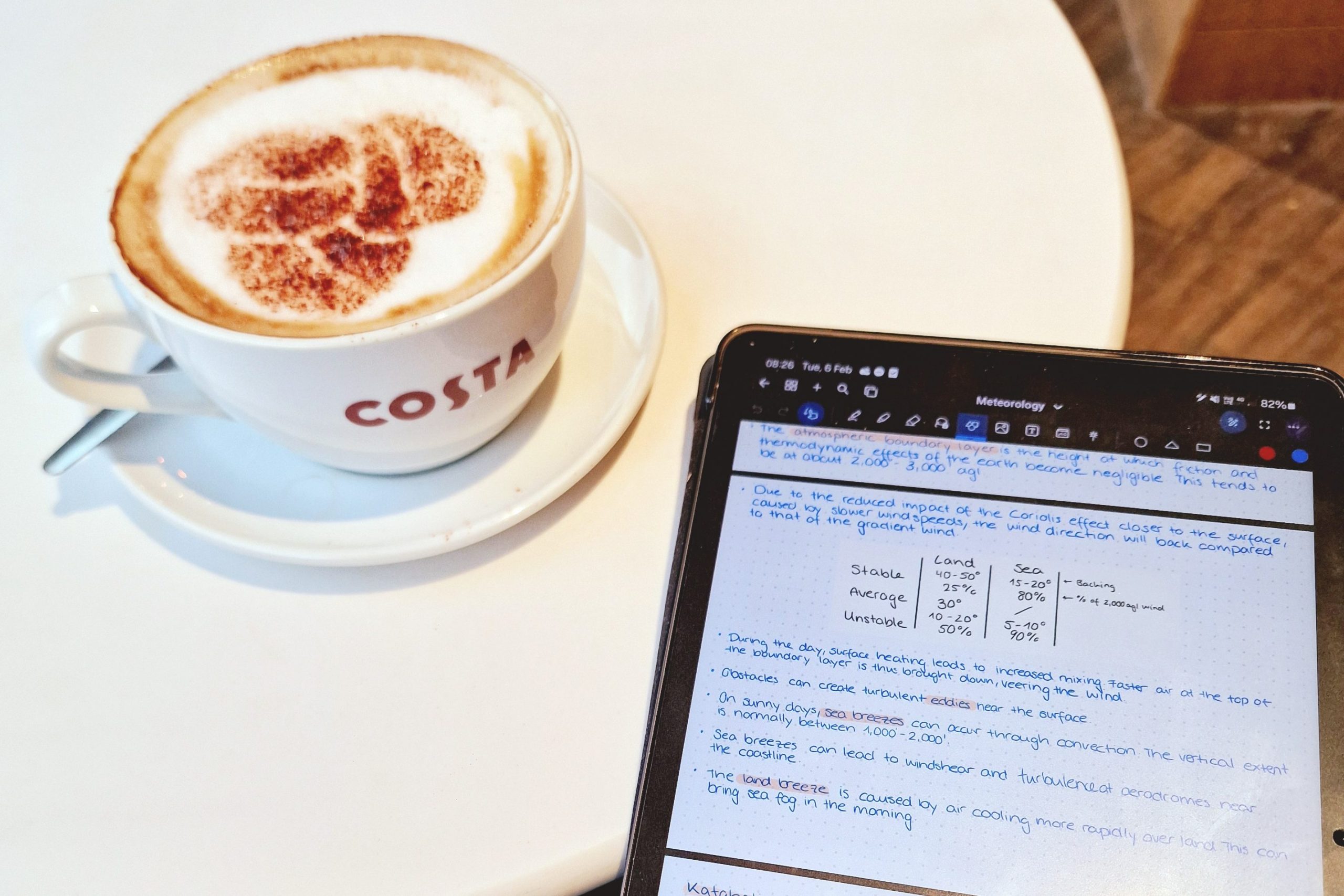
For many of us, the PPL exams are the first return to written examinations since graduating from the last form of formal education, adding the challenge of finding the best study strategy to prepare for these exams on top of the unfamiliarity with the CAAs e-Exam layout and the content of the material to be studied.
Despite a few small hurdles along the way, I have recently completed the last of the 9 theoretical examinations with no failures and a couple of 100% results. While I certainly wouldn’t want to claim that my method was by any means perfect, I hope it’ll provide a sound foundation for yourself to find the strategy that helps you success throughout these exams and acquire a solid understanding of aviation theory that’ll allow you to become a safe and confident pilot.
The Process
Initial Registration & e-Exam Booking
When you begin your training, you will sooner or later be asked to register for the CAA online portal, through which you will receive your CAA reference number. There really is no reason to delay getting registered once you commence your training, as you’ll need this account to apply for your pilot medical and to access the Private Pilot Theoretical Knowledge e-Exams service. Both of which are steps you will need to have taken by the time where you fly your first solo, so don’t wait too long!
Once you’ve been granted access to the e-Exams service you’ll be able to link it to your flying school, which then just needs to approve this connection to be able to manage your examinations.
In my case, the bookings were organised by my ATO, meaning I called them to schedule an exam slot and they then created the booking with the CAA on my behalf. This process might be different for your flying school however, therefore please make sure to ask them for information on how to correctly book your exams.
As soon as a booking has been created, you’ll receive an automated confirmation e-mail for the exam. In the attached PDF, you’ll find some important information for the specific exam you’re scheduled to sit, for example the time you’ll have available to complete the exam and the equipment that is permitted to be used.
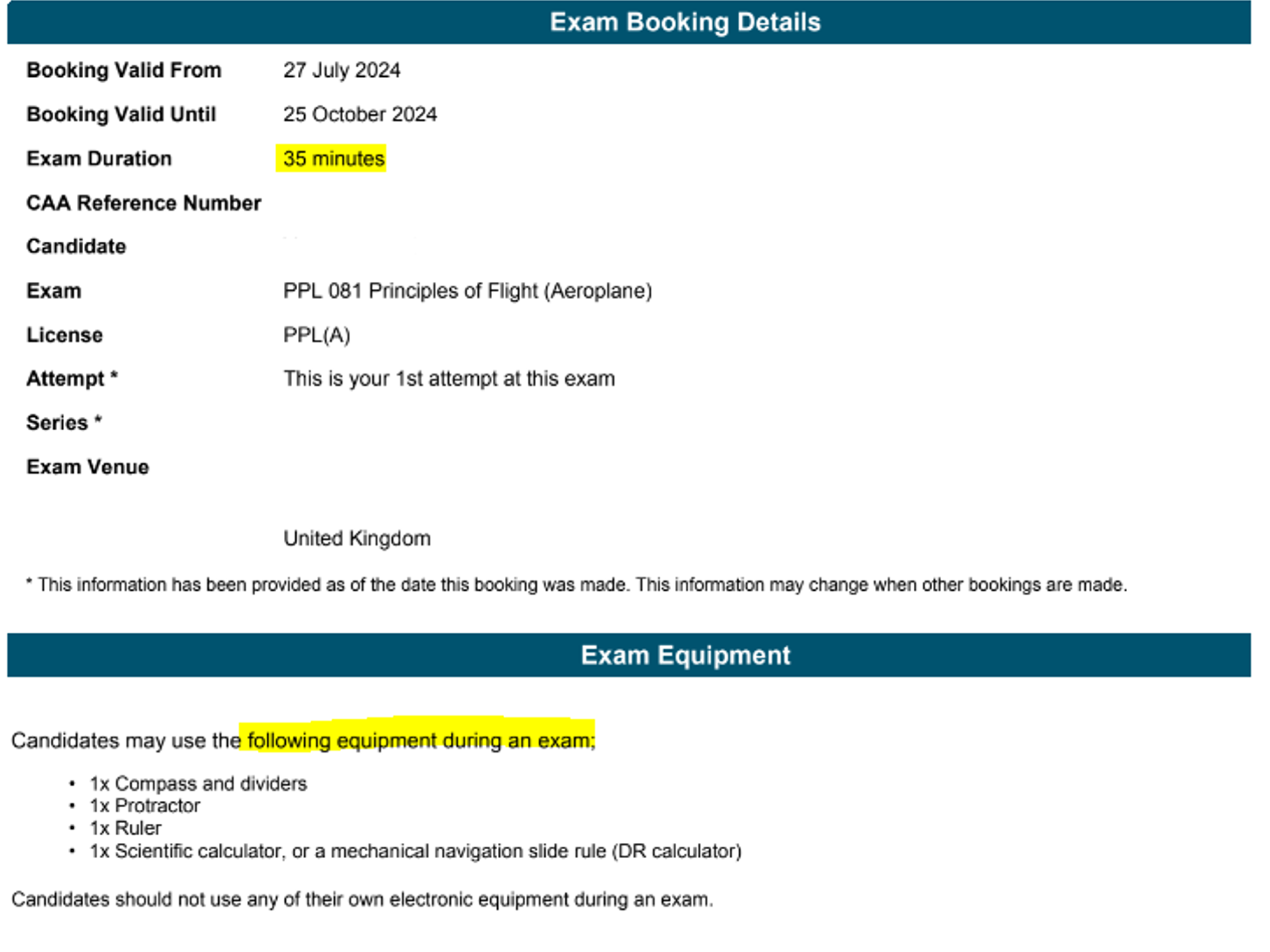
Further information on the procedures and conduct of the GA Theory exams can be found in Standards Document 11, which can be downloaded from the CAA website.
Sitting the exam
Just as the bookings, this can vary depending on the organisation that you’ve chosen to sit your exams with. In any case however, the exams must be sat in person at a location approved by the CAA.
I sat the exams at my flying school in a small room that housed the school’s servers and a large print of a photo showing one of the aerodrome’s hangars at night with an Extra AE-200 parked in front of it. This photo will forever be burned into my memory as I’ve spent a good amount of time staring at it while thinking about the question that was currently displayed on the screen.
Anyways, back to the point of this article, in my case I chose to arrive roughly 15min before the exams, which gave me time to go over my notes one final time and commence the exam without any unnecessary stress.
Although the flying school provided a few tools for the exam I did prefer to bring along my own, particularly when it comes to the flight computer, as using the exact same one you’re already familiar with just makes the brain cells run a little bit more smoothly.
Make absolutely sure that you have all the materials you need with you in the exam room and that you are fully ready to take the exam, prior to starting it. Once you have agreed to the exam conditions and instructions, the timer will start and you will go through to the exam which will look like this:
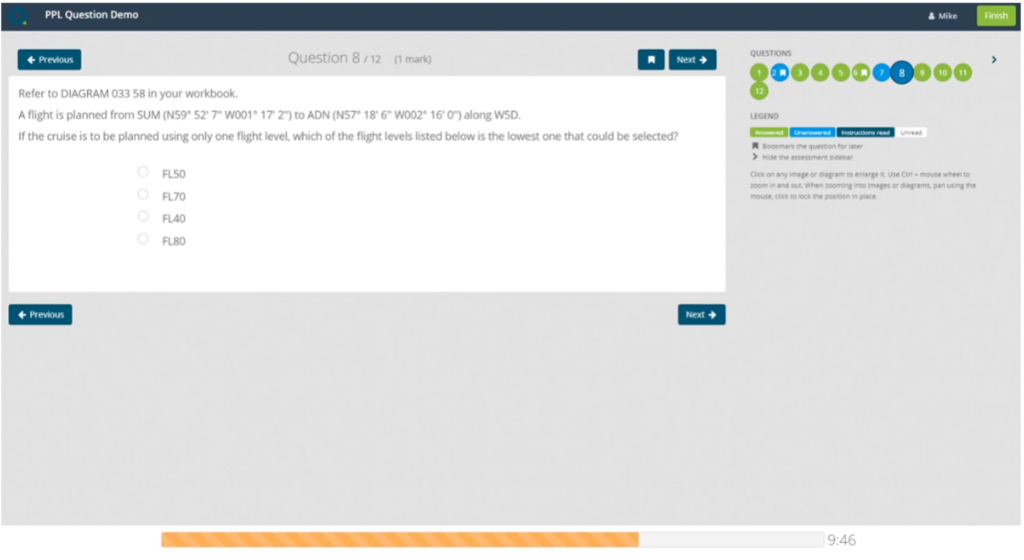
Some questions may contain images or files that will need to be used to answer the question. For the Flight Performance & Planning Exam you should also be given a printed version of the supplementary information (such as landing and take-off performance graphs) and a current 1:500,000 VFR chart. Make sure you verify that the chart is current prior to starting the exam. You should know how to do this by the time you get into this situation in the first place.
Within the exam you can bookmark any questions you want to come back to at a later point. This also prevents you from accidentally terminating the examination before you have proofread your answers.
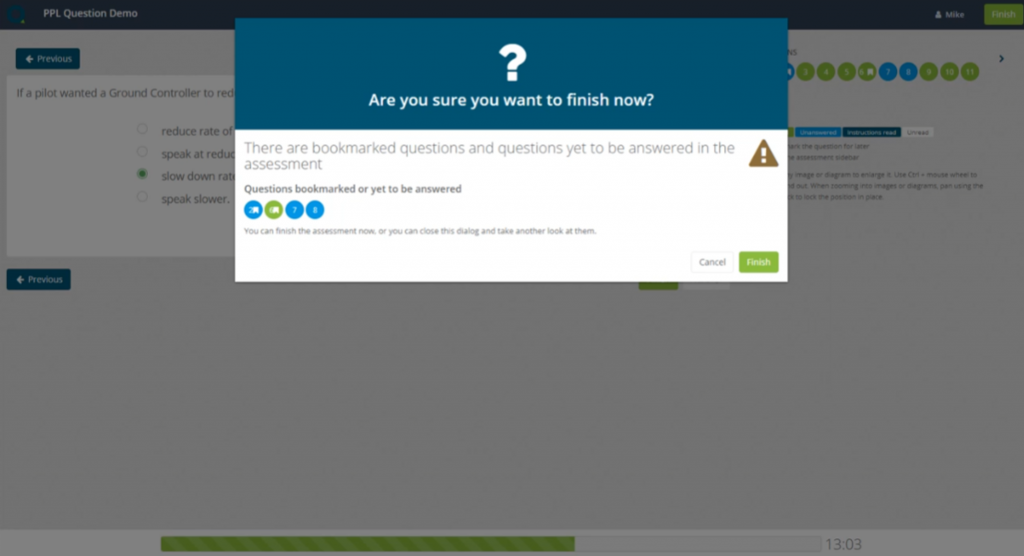
For most of the examinations, you’ll likely have plenty of time left after answering all questions. I highly recommend using this to go over the questions again with a fine comb and to look for any particular wording that could change the appropriate answer. This has helped me correct my answer before, where I only spotted that a figure was given in height rather than altitude on the second read through. A seemingly small difference that lead to a completely different answer!
However, aim to not lose too much time on an individual question if you get stuck. Try to complete as many as you can within the least amount of time to leave more time for the challenging ones, then use any remaining time to verify you’re happy with the answers you have selected. This is especially relevant for exams such as Navigation and Flight Performance & Planning, where some questions may require more calculations to be made while others will simply ask for a simple knowledge based question.
Remember that you need to answer 75% of the questions correctly in order to pass. Therefore, in a worst case scenario, it is better to have confidently answered the “easy” questions correctly and leave one of the challenging questions unanswered, rather than having completed the more challenging ones, potentially incorrectly, and then running out of time to answer the simple ones that would have raised your grade to a pass.
In summary, here are the durations and amount of questions asked per exam. Note that these figures are only accurate as per the time of writing. Therefore make sure you check with your flying school or the CAA for the latest guidance.
| Examination | Questions | Time |
|---|---|---|
| 010 Air Law | 16 | 35min |
| 020 Aircraft General Knowledge | 16 | 35min |
| 030 Flight Performance & Planning | 12 | 45min |
| 040 Human Performance | 12 | 25min |
| 050 Meteorology | 16 | 50min |
| 060 Navigation | 12 | 45min |
| 070 Operational Procedures | 12 | 30min |
| 081 Principles of Flight (Aeroplane) | 12 | 35min |
| 090 Communications | 12 | 20min |
Recommended Order of the Exams
Make sure you speak to your flying school, as they may have a set order in which they would like you to complete the exams. In my case, I was able to chose freely. Although this isn’t exactly the same order that I have taken them in, the order in which I recommend taking the exams is the following:
- Air Law
You will need to complete this exam prior to flying your first solo, so aim to get it out of the way as early as possible. - Human Performance
I suppose this could be left to a later point, however, I am confident that having a good understanding of human factors early on in your training will help you build good habits early on, including good airmanship, CRM and TEM skills. - Meteorology
- Communications
- Operational Procedures
Many of this topic’s learning objectives contain and expand on information that you’ll already have learned for the previous exams, if you take them in this order. - Navigation
- Principles of Flight
- Aircraft General Knowledge
This topic requires you to already have a general understanding for the principles of flight, therefore it is recommended to take the PofF exam prior to AGK. - Flight Planning and Performance
This exam should be seen as a combination of all the topics you have learned so far and focuses on the practical application of this information. You will need to have studied the other subjects prior to taking this exam.
Materials
There are various ways how you can acquire the knowledge for your PPL theory exams, including digital courses, classroom training, books, videos and certainly many more. My recommendation is to do a bit of research, read the reviews and find the option that works best with your learning style.
I found that for myself, self-paced study using physical books and handwritten notes are the most effective method to memorizing information, supported by online practice exams to find my knowledge gaps and to familiarize myself with the types of questions that would be asked in the exams.
In principle, my method of study was the following:
- Look up the learning objectives for the relevant exam on the CAA’s website (Check the end of this article to find the link to these files).
- Read the Volume in the Pooley’s Air Pilot’s Manual.
- Go over the book again and write a handwritten summary of the subject, focusing on any topics that would need some focus to memorise or where I needed to invest more time to fully understand them.
- Begin taking practice exams.
- Research further: Look up videos, read safety sense leaflets, talk to pilots and use any resource available to fill any remaining knowledge gaps.
- The day before the exam, write a shorter summary of the topic, focusing on any information that I knew I wanted to review again in the time up to immediately before the exam.
Let’s take a closer look at the materials I’ve used to study:
The Pooley’s Air Pilot’s Manuals
These books were the foundation for my preparations. I’ve heard mixed feedback from others who tried different materials along with these books and I do agree that there is some repetition within them, however the writing style makes sure that even I can wrap my head around the concepts being discussed.
Having a physical book to study also allows you to highlight text within the pages and to study nearly anywhere anytime, even if you only have a few minutes.
The APM consists of a total of 7 volumes. Volume 5 focuses on instrument flying, worth getting as well if that is something you plan on doing in the future, however for the PPL, volumes 1-4 and 6-7 are sufficient.
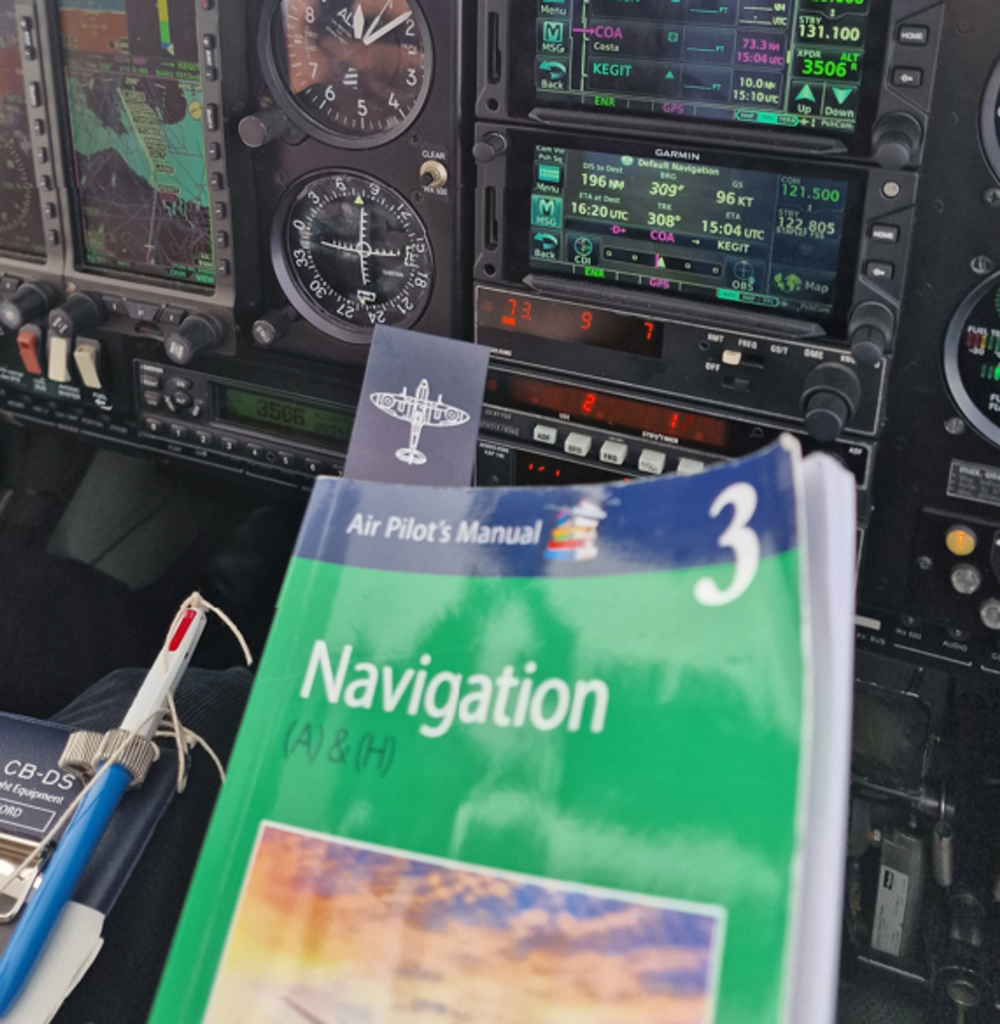
EasyPPL Ground School
Easy PPL offers a fantastic database of questions for all of the PPL exams. You can also buy the ground school courses through this website which you can use alongside or instead of the books for your studies. I personally found that the books provide a bit more explanation for the topics and that I prefer having a physical print of the information to go through, but this is down to preference in the end so I do recommend giving at least one of the courses a try before you decide.
The question banks have been recommended to me by flight instructors and fellow PPL students alike. You’ll find that the format of the question very closely resembles that of the CAA examinations and that even the wording can be quite similar. After completing a practice exam, you can review all questions and access an explanation for each one. You can also track your practice exam results and are issued a certificate of exam readiness, once you have successfully passed a number of practice exams.
The one thing to be aware of is that the question bank only remains temporarily available to you (unless you purchase a starter kit), therefore ensure you only buy access to them within a month of the planned exam date.
AirQuiz
Another useful question bank website is AirQuiz. I’ve used this website alongside with EasyPPL as it provides a few more challenging questions to prepare for the exam. It is important to note that these are the EASA PPL(A) exams, therefore there might be a few differences to the UK Part-FCL PPL(A) theory. These practice exams are not timed and you do not receive a detailed explanation for each question you answer incorrectly, however, you do receive an email after completing an exam which lists all questions along with the correct answers, as well as a summary of which topics they suggest for you to review further.
Quizlet
Quizlet is a free flashcard website which also comes with a useful app that you can use to study on the go. There are already a number of PPL Theory sets available through Quizlet, most of which were created by fellow students!
This can be a very useful way to study information quickly (I used the app for example to study air law while on my lunch breaks at work). Do however remember to proofread the flashcards if you use a set created by someone else.
Here’s one of mine containing Standard RT words and phrases:
Notion & Notewise
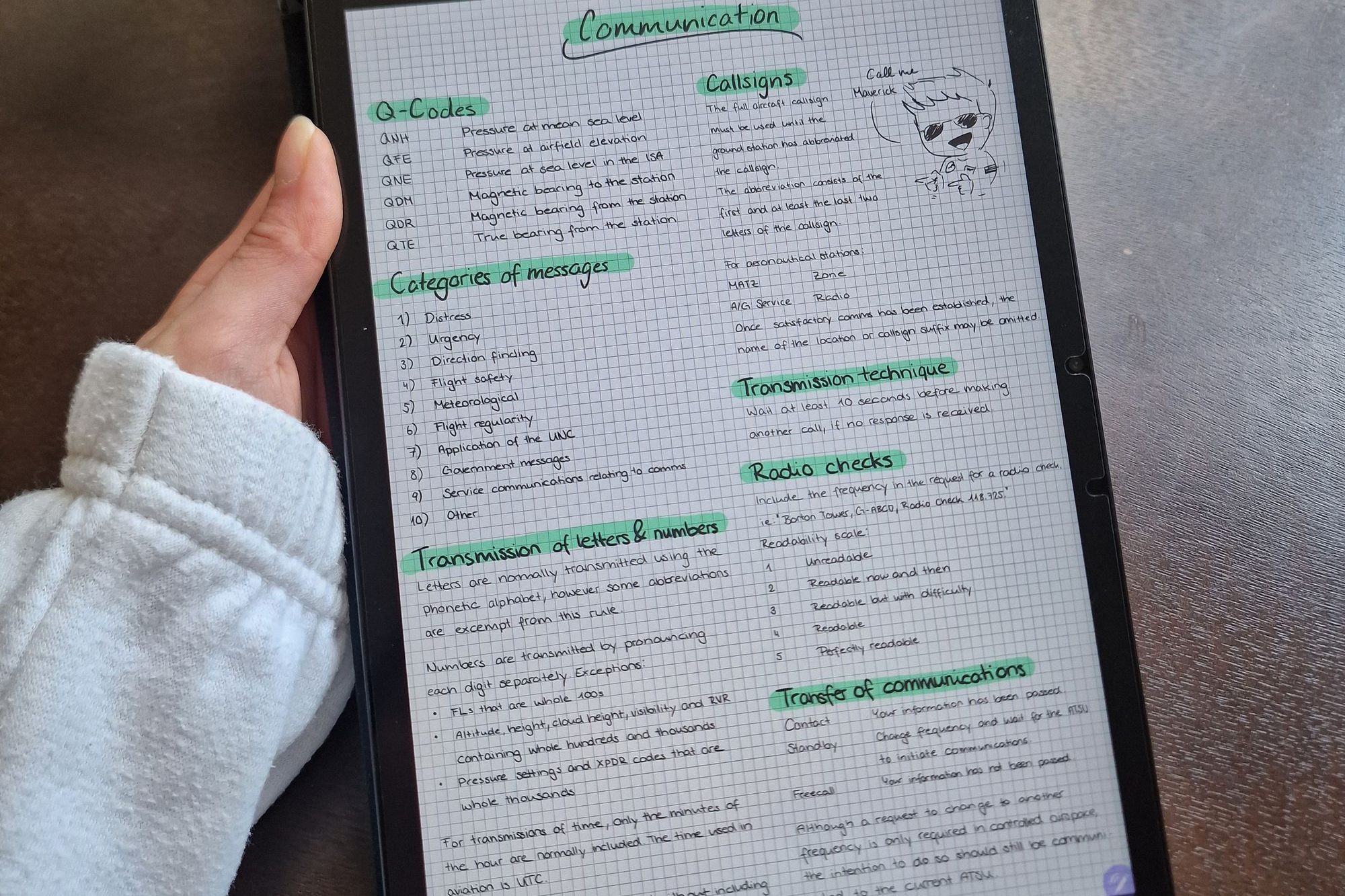
Both applications are free and I highly recommend them for your note taking, if you prefer doing this digitally rather than on paper.
I initially used Notion exclusively and created a notebook per topic. In fact, I am writing the initial draft for this article in Notion as well, it’s become my go to place for all my writing!
However, I’ve found that handwriting my notes is something I quite enjoy doing and that it helps me memorise information more easily. This made some of the long evenings revising more fun and kept me motivated to study the materials.
The app I started using for this is called Notewise, which I have been using on my tablet to create summaries of the topics I had been studying.
Paper
One or two nights before attending the exam, I always wrote down the most important points that I felt I would benefit from re-reading regularly leading up to the exam, limited to a maximum of 2 pages.
These summaries I would keep in my pocket and re-read at every given opportunity, up to immediately before the exam. I used this especially to study information that needed to be precisely memorised, such as take-off and landing safety factors, minimum height rules, VFR Minima and so on.
Other
Just as you should do in flight, you should aim to use all resources available to you to achieve the best possible outcome. The CAA publishes highly valuable safety sense leaflets which are a great study aid alongside materials listed above. https://www.caa.co.uk/general-aviation/safety-topics/safety-sense-leaflets/
Furthermore, there are many more official documents available online that you can use for your studies.
A collection of links to some recommendations can be found at the end of this article.
Make sure you keep note of questions that you need help with and reach out to your flight instructor, pilot friends and family or even forums and social media. I’m personally incredibly grateful for the help I have received from experienced friends and even people online, who have been beyond generous in their support. If you would like to, you are also more than welcome to reach out to me and, although I certainly won’t know everything, I can still try to help you find someone or a resource that has the information you are looking for!
Finally, while you should exercise caution with using resources found from blogs (heh), youtube and social media, you can still find a lot of helpful resources online to help with your studies. A good example of this would be where I got a little bit stuck understanding how an ignition system works and through watching a few helpful animations on YouTube, was able to gain some clarity.
Conclusion
The exams really aren’t as scary as they may seem at first. Get yourself into the situation of being well prepared, well rested and confident prior to the exam. Make sure you have studied all the learning objectives relevant to your exams by checking the list published by the CAA found here: https://www.caa.co.uk/general-aviation/pilot-training-organisations/ga-theoretical-knowledge-e-exams/
And verify that you can apply this knowledge by taking multiple practice exams, until you’ve achieved at least a few 100% results.
Useful Resources
Important: This article was published completely independently of any of the organisations and businesses mentioned. I take no responsibility for the accuracy and currency of any of the information provided within this page, nor for that contained within any of the links provided.
- Learning Objectives (CAA)
https://www.caa.co.uk/general-aviation/pilot-training-organisations/ga-theoretical-knowledge-e-exams/ - Standards Document 11 (CAA)
https://www.caa.co.uk/publication/download/12697 - Radiotelephony Manual CAP 413 (CAA)
https://www.caa.co.uk/our-work/publications/documents/content/cap-413/ - UK Flight Planning Guide CAP 694 (CAA)
https://www.caa.co.uk/our-work/publications/documents/content/cap-694/ - Visual Aids Handbook CAP 637 (CAA)
https://www.caa.co.uk/our-work/publications/documents/content/cap-637/ - Safety Sense Leaflets (CAA)
https://www.caa.co.uk/general-aviation/safety-topics/safety-sense-leaflets/ - UK SERA (CAA)
https://regulatorylibrary.caa.co.uk/923-2012/Content/SERA%20923-2012_1.htm - Air Navigation Order 2016
https://www.legislation.gov.uk/uksi/2016/765/contents - AIP (NATS)
https://nats-uk.ead-it.com/cms-nats/opencms/en/Publications/AIP/ - UK Standardised Rules of the Air
https://regulatorylibrary.caa.co.uk/923-2012/Content/SERA%20923-2012_1.htm - The Skyway Code CAP1535S (CAA)
https://www.caa.co.uk/our-work/publications/documents/content/cap1535s/ - Get Met (Metoffice)
https://www.metoffice.gov.uk/binaries/content/assets/metofficegovuk/pdf/services/transport/aviation/ga/getmet.pdf
One Response
Very good writeup. Well done on passing all your exams.